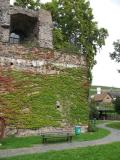




















































On our way home from a two-week trip to Croatia, we had a chance to spend 48 hours in Germany, staying with a Dartmouth friend of ours, Cara Kinsey, who lives in Frankfurt-am-Main. We decided to spend Saturday, September 25, exploring the nearby Rheingau wine country and the town of Rüdesheim-am-Rhein. This was our first wine tasting adventure in Europe. We didn't really go out with much of a plan, and stopped at wineries as whim dictated.
These photos are copyright © 2010 Kenneth E. Harker. All rights reserved.
 |
Our first stop was Schloss Reinhartshausen, the largest winery in the Rheingau with about 200 acres (80 ha) of vines. Wine grapes were first cultivated on the estate in 1337, which in recent centuries has been owned by Prussian nobility. |
 |
Some of the buildings in the large estate at Schloss Reinhartshausen. In addition to the winery and tasting room, the estate also featured a restaurant and a hotel. |
 |
Vineyards at Schloss Reinhartshausen. As with all the wineries in the Rheingau, the main grape varietal is Riesling. |
 |
This is the Pfarrkirche Sankt Markus (Catholic parish church of St. Mark) in the town of Erbach-am-Rhein, across the street from our first winery visit. |
 |
Vineyards were everywhere on our drive to the next town downstream. The road we were on paralleled a railroad line. |
 |
Grapes were even cultivated in residential yards. I'm sure that there are many home winemakers in the area. |
 |
Our next stop was Weingut Balthasar Ress in the town of Hattenheim. |
 |
Some of the vineyards at Weingut Balthasar Ress, looking to the north. |
 |
Our third stop was Weingut Heinrich Eser in the town of Oestrich. This was my favorite stop of the day - a small family winery that makes outrageously good wine for the prices they charge. |
 |
Cara, tasting some of the wine at Heinrich Eser. |
 |
Jen, in the very nice tasting room. You could comfortably fit about six people in the room at once. |
 |
Helmut Eser, the winemaker. The winery is named after his grandfather. |
 |
Mr. Eser was kind enough to give us a cellar tour. Although the winery was founded only in 1917, it has an extensive library collection. |
 |
Wines stored behind iron bars. |
 |
Jen, in the barrel room. |
 |
Mr. Eser spoke some English, but mostly he spoke German and Cara translated for us. |
 |
Some more old bottles. Authentically old. Covered in cave dander old. |
 |
Weingut Heinrich Eser uses very large, old oak barrels in which to age their wines. |
 |
Bottles of Kabinett Riesling from the 2006 vintage that still need to be labeled. |
 |
What the bottles look like without labels. |
 |
The wine is fermented in stainless steel tanks that can be precisely controlled to keep the wine at the optimum temperature during the fermentation process. |
 |
After the wine is fermented, it ages in these large oak barrels before bottling. Because these are old barrels that have been used before, the wood does not do much to affect the flavor of the wine. |
 |
Above the cellar is the garage where the family tractor lives. |
 |
This is a Braud grape harvesting machine. While it straddles the trellis of a row of grapes, mechanical fingers shake the vines just enough for ripe bunches of grapes to fall onto a collection belt running underneath the vines. A series of conveyor belts deposit the grapes into a trailer that travels down the row next to the harvester. |
 |
Our next stop was Weingut Querbach at the northern edge of the town of Oestrich. Although the winery was founded in 1650, there's been a lot of recent investment in a modern winery and tasting room. |
 |
Looking north from the deck outside the winery building, all you see is vineyards extending into the hills. Almost all of these vineyards are planted in Riesling. |
 |
Some of the wines we tasted at Weingut Querbach. |
 |
The winery dog, lounging in the tasting room. |
 |
A rose bush at Weingut Querbach. Many wineries plant roses around vineyards as an early warning system of sorts. Roses and grapevines are susceptible to many of the same sorts of pests and diseases, but roses often exhibit symptoms earlier, when the problem might still be manageable. |
 |
A fountain in the Marktplatz ("Market Square") in the center of Oestrich. |
 |
The Marktplatz in Oestrich had a cafe and a hotel. The building on the left ("Altes Rathaus") is the old city hall, which has been converted into a wine bar. Today, the neighboring towns of Oestrich and Winkel have a single, unified municipal government. |
 |
A hotel called Gasthof zur Krone on the Marktplatz, which apparently has been a going concern since the year 1540. |
 |
The steeple of Sankt Martinskirche in Oestrich (St. Martin's Church in Oestrich), a Catholic parish church. A church has been at this location since the year 1000, but this building only dates back to 1648. The church building was rebuilt after the previous building was burned to the ground in 1635 during the Thirty Years War. |
 |
Our last winery stop was a Straußwirtschaft on the Marktplatz called Weingut Hans Walter. Straußwirtschaft are a type of seasonal pub or tavern where winemakers sell their own wine and maybe a few small cold plates on their own premises. |
 |
Hans had a fondness for interesting wineglasses. No Riedel stemware here. |
 |
Hans brought out an empty bottle from the 1999 vintage to show us. The uniquely-shaped blue bottle was an attempt to establish a distinctive bottle design for the region that would be instantly recognized in a shop as a Rheingau wine. It did not catch on. |
 |
Cara, enjoying the atmosphere at Weingut Hans Walter. |
 |
Hans had a nice garden in front of the house. |
 |
The Brömserburg Castle in Rüdesheim-am-Rhein was built between 800 AD and 1000 AD on the site of a ruined Roman watchtower. The castle was sold to the town government in 1940, and in 1950 the Rheingauer Weinmuseum Brömserburg opened. It claims to be the oldest wine museum in the world. |
 |
Ivy growing on the wall of the Rheingauer Weinmuseum Brömserburg. |
 |
Brömserburg Castle. |
 |
The wine casks in the yard are supposedly among the largest wine casks in the world. |
 |
Vineyards in Rüdesheim-am-Rhein in front of Boosenburg Castle, a private residence. Behind the castle, a gondola takes tourists from the town up to the Niederwalddenkmal, a monument constructed to commemorate German unification in 1871, following the conclusion of the Franco-Prussian War. The monument was completed in 1883. |
 |
The town of Rüdesheim-am-Rhein was full of tourists. It is part of the Upper Middle Rhine Valley UNESCO World Heritage Site. |
 |
This group called the Blue Band just assembled at a street intersection and started playing. They weren't especially good. But they were very blue. Well, not Blue Man Group blue. And they weren't all men. |
 |
Some of the old buildings in Rüdesheim-am-Rhein. |
 |
The Mittelalterliches Foltermuseum (Middle Ages Torture Museum). We passed on it. |
 |
More tourists. |
 |
Rüdesheim-am-Rhein is apparently very popular with Japanese tourists, as this signs outside a weinhandel (wine shop) attests. |
 |
It was the season for federweißer. Federweißer is essentially very young white wine. Typically 4 percent alcohol by volume, federweißer is cloudy with suspended yeast and naturally carbonated, as the beverage is still fermenting. The bottles cannot be sealed or they might explode. A glass was €0.90 or about $1.25. We tried federweißer made from both white wine grapes and red wine grapes. |
 |
Ivy on one of the buildings downtown in Rüdesheim-am-Rhein. |
 |
More classical German architecture. |
 |
Leaving the Rheingau wine region. Auf Wiedersein! |
| Last Updated 1 August 2018 |